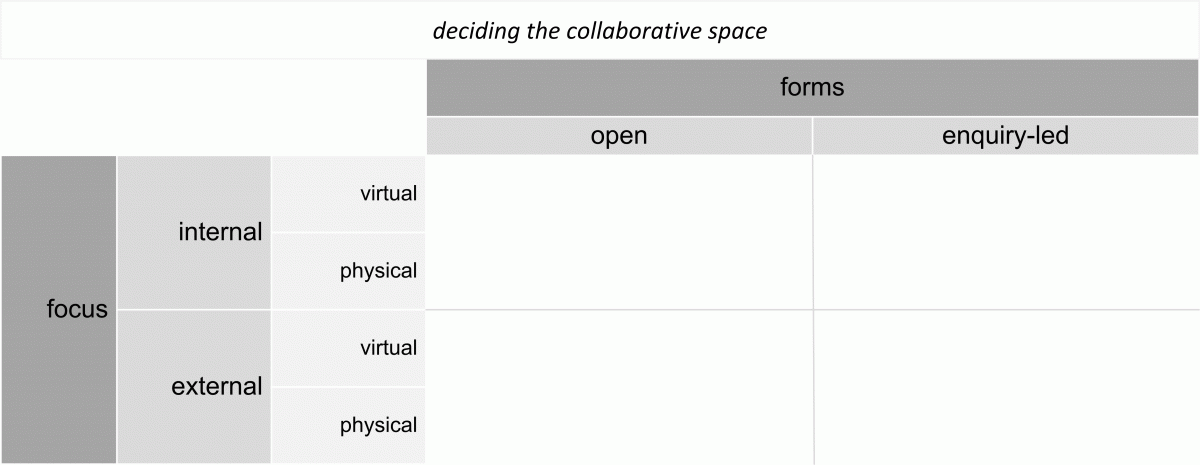The following quote from Peter Koestenbaum’s Leadership: The Inner Side of Greatness affects me greatly. I think about his words all the time.
“The ground rule is that all authentic products (including services) must contain within them at least one element or module of leadership information. Thus, whatever else you sell, you are also selling leadership help to your customers. This is a fundamental principle of ethical and successful business transactions.”
In my work I ask myself, “What does it mean for me to help my client realize their potential for leadership in their practice of collaborative innovation?”
Koestenbaum offers as his first leadership proposition: “be effective—emphasize results, both through management by objectives and by process.”
At times my clients and I experience transformative breakthroughs. The vision they create for their organization, coupled with the realistic view of where the organization stands in its development, enables them to help their colleagues unlock their potential through the practice of collaborative innovation. Effectiveness abounds.
Ideas, conceived in the earliest time of the front end of innovation, represent possibilities. Potential. Asking someone to open their mind to the possibilities—how might we achieve something—opens the door to leadership.
Organizations that pursue the practice benefit first and foremost by helping their people develop a leadership mind.
The practice of collaborative innovation is the practice of leadership. Organizations that pursue the practice benefit first and foremost by helping their people develop a leadership mind. Ideas, absent leadership, fail to grow beyond the stage of fleeting whimsy. When organizations challenge themselves to become more innovative in the public square, they challenge themselves to realize more fully their leadership potential. Few may find the courage to phrase their intent in such stark, realistic terms. Doing so, however, opens wide the door to authentic transformation.
My experience tells me that people, alive to their potential, will cross the threshold, given the opportunity.
Be effective
Being effective in helping others see the possibilities of collaborative innovation presents the same challenges as any other form of advocacy. You need a way to tell your story, morning glory. Do people understand your vision? Does your vision resonate with them? Can you show them a way to make your intent reality—that you grasp the details?
By contrast, we in our work encounter people we find genuinely likable—at least at first. We consider inviting them to dinner. We foresee a round of golf. In time, however, their inability to get to the point frustrates and fatigues us. What do they want, exactly? Do they know? We don’t. We look for ways to avoid them. Nobody who wants to realize their leadership potential wants to be that person: the bore.
I encourage clients to practice depicting their story on one page: the collaborative innovation blueprint (figure 1). The real, physical limits of a page demands clear thought and a succinct story. Simplicity, as with speed, offers potent leverage.
Figure 1: the blueprint for collaborative innovation
The blueprint fits on a sheet of copy paper (e.g., 8.5 x 11 inches in the U.S.). At the top left appears strategic intent (figure 2). Followers of Robert Kaplan and David Norton will recognize this section as the balanced scorecard. Kaplan and Norton developed a simple, visual way for leaders to map and convey their strategy. Their approach works well in providing strategic context for collaborative innovation. Per Koestenbaum, leadership begins with effectiveness: results achieved, relative to goals set. The Balanced Scorecard lends itself well to depicting goals and the means by which people will achieve them: the why.
Figure 2: Kaplan and Norton’s scorecard applied to the practice of collaborative innovation

To the right of the scorecard on the blueprint appears the collaborative space (figure 3). This space provides the leader with a place to indicate where they intend to engage the community on the critical questions facing the organization. Does the leader plan to engage people within the organization—internal focus? Clients, suppliers, or the world at large—external focus? Does the leader plan to create a space for open, or free-form, innovation? This part of the blueprint helps the leader tell the story of engagement: the what and the who.
Figure 3: the collaborative innovation space
At the bottom of the blueprint comes the process view, mapped to the front and back ends of innovation: the when and the how (figure 4). When does the enquiry with each community in each form begin? How does a day in the life of an engagement proceed? When can the organization expect results, relative to realizing intent? What points of connection exist between the front and back ends of innovation.
Here, we think of the mechanics of engagement: roles, incentives, communications, and resources.
Figure 4: managing the campaign
The blueprint helps the people who lead their organization’s practice of collaborative innovation link vision with the reality of the engagement on one page. It serves as a useful tool for helping people see and connect the dots by way of making the story their own. Effectiveness becomes possible.
Applying the blueprint
The following figure shows the blueprint in action (figure 5). Envision using this approach to share your vision and to tell your story on a page.
Figure 5: applying the collaborative innovation blueprint
In this example, the fictional organization decides to improve margins by reducing customer churn. For them, losing a premium client materially reduces profits. Feedback from members of the organization’s executive advisory board indicates that increasing the number of calls that they can resolve the first time that clients contact them will increase satisfaction and reduce churn. Client executives also observe that they have to go outside the organization to get products and services they believe the organization could—and should—offer.
The leader of the organization’s collaborative innovation program captures this perspective in the scorecard part of the blueprint.
The leader then engages the campaign team to craft the critical question and identify the communities to engage. Through dialogue, they arrive at what the collaborative innovation portion of the blueprint depicts in figure 5. They plan to approach the organization’s associates who are closest to the work on the question of improving first call resolution. They will host a World Café with the associates to explore the critical question and then provide a virtual space where the associates can continue to develop their insights and idea after the café ends.
They decide to approach the premium clients on helping them to understand unmet needs. They start first with the premium clients who are members of the executive advisory board: the same group who helped the organization shape its intent.
Lastly, the leader maps out the flow of the engagement. They take into account the relative availability of the associates and clients. They consider the downstream implications of the flow. Front end ideation with the associates segues nicely into the organization’s practice of lean. The leader reaches out to their colleagues in the lean program office to share their vision and to explore the possibilities to collaborate. The blueprint resonates with the lean practitioners: it mirrors their use of the A3 for the same purposes.
The leader also reaches out to their colleague who is exploring the practice of design thinking. The organization will need to vet the ideas that the executive advisory board generates. Design thinking, in which practitioners immerse themselves in the end user’s environment, offers a promising way forward. The leader of the practice uses the blueprint to share their thinking with this individual, as well.
Creating a satisfied customer
David Koestenbaum writes, “If you teach leadership to your customers, then you will prosper, for you will have created a satisfied customer.”
The blueprint for collaborative innovation serves as a means to this end: a way for you, as a practice leader, to help people—your customers—map their strategic intent to their collaborative innovation space and their process for managing the individual campaigns.
What possibilities open when ten percent of the people in your organization try the blueprint? Twenty-five percent? Half? What possibilities open when people begin improving its design as they adapt it for their own use?
At what point does the joy of leadership—effecting authentic transformation and realizing powerful results—arrive?
Lastly, what is your plan to teach leadership within your organization so that you prosper? Your own transformation and prosperity begins when you consider that your practice of collaborative innovation serves as a means to this end.
By Doug Collins
About the author:
 Doug Collins is an Innovation Architect who has specialized in the fuzzy front end of innovation for over 15 years. He has served a variety of roles in helping organizations navigate the fuzzy front end by creating forums, venues, and approaches where the group can convene to explore the critical question.
Doug Collins is an Innovation Architect who has specialized in the fuzzy front end of innovation for over 15 years. He has served a variety of roles in helping organizations navigate the fuzzy front end by creating forums, venues, and approaches where the group can convene to explore the critical question.
As an author, Doug explores the critical questions relating to innovation in his book Innovation Architecture, Practical Approaches to Theory, Collaboration and Implementation. The book offers a blueprint for collaborative innovation. His bi-weekly column appears in the publication Innovation Management.











